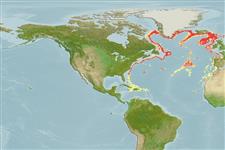Teleostei (teleosts) >
Alepocephaliformes (Slickheads and tubeshoulders.) >
Alepocephalidae (Slickheads)
Etymology: Alepocephalus: Greek, alepos, alepidotos = without scales + Greek, kephale = head (Ref. 45335).
More on authors: Goode & Bean.
Environment: milieu / climate zone / depth range / distribution range
Ecology
Marine; bathydemersal; depth range 365 - 1700 m (Ref. 4460). Deep-water; 66°N - 17°N, 78°W - 0°E
Eastern Atlantic: Greenland and Iceland southward to 17°N. Western Atlantic: Greenland to Grand Banks and 29°52'N, 77°09'W.
Length at first maturity / Size / Weight / Age
Maturity: Lm 55.0 range ? - ? cm
Max length : 100.0 cm SL male/unsexed; (Ref. 4460); max. reported age: 38 years (Ref. 41452)
Found over ooze and sand bottoms (Ref. 4736). Bathypelagic (Ref. 58426). Feeds mostly on coelenterates, but also decapods, tunicates and fishes (Ref. 4736).
Annual fecundity indeterminate (Ref. 51440).
Markle, D.F. and J.-C. Quéro, 1984. Alepocephalidae (including Bathylaconidae, Bathyprionidae). p. 228-253. In P.J.P. Whitehead, M.-L. Bauchot, J.-C. Hureau, J. Nielsen and E. Tortonese (eds.) Fishes of the North-eastern Atlantic and the Mediterranean. UNESCO, Paris. Vol. 1. (Ref. 4736)
IUCN Red List Status (Ref. 130435)
Threat to humans
Harmless
Human uses
Fisheries: minor commercial
Tools
Special reports
Download XML
Internet sources
Estimates based on models
Preferred temperature (Ref.
123201): 3.4 - 10.2, mean 6.9 °C (based on 170 cells).
Phylogenetic diversity index (Ref.
82804): PD
50 = 0.5000 [Uniqueness, from 0.5 = low to 2.0 = high].
Bayesian length-weight: a=0.00316 (0.00189 - 0.00529), b=3.19 (3.04 - 3.34), in cm total length, based on LWR estimates for this species & (Sub)family-body (Ref.
93245).
Trophic level (Ref.
69278): 3.7 ±0.54 se; based on food items.
Generation time: 13.9 ( na - na) years. Estimated as median ln(3)/K based on 1
growth studies.
Resilience (Ref.
120179): Low, minimum population doubling time 4.5 - 14 years (K=0.077; tmax=38; Fec = 458 (per batch)).
Fishing Vulnerability (Ref.
59153): High to very high vulnerability (69 of 100).
Climate Vulnerability (Ref.
125649): Moderate to high vulnerability (47 of 100).
Nutrients (Ref.
124155): Calcium = 15.6 [8.0, 45.5] mg/100g; Iron = 0.408 [0.139, 1.088] mg/100g; Protein = 11.5 [9.6, 14.7] %; Omega3 = 0.351 [0.149, 0.942] g/100g; Selenium = 29.1 [12.3, 69.9] μg/100g; VitaminA = 11.9 [2.5, 59.1] μg/100g; Zinc = 0.334 [0.210, 0.548] mg/100g (wet weight); based on
nutrient studies.
